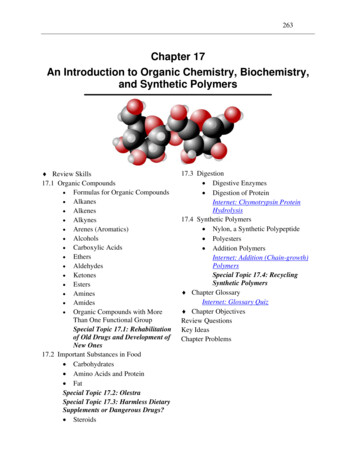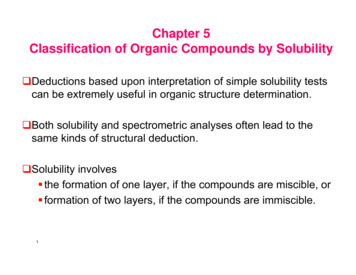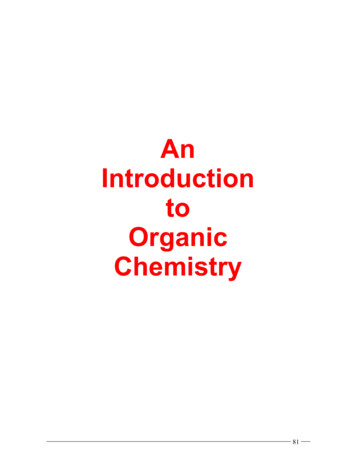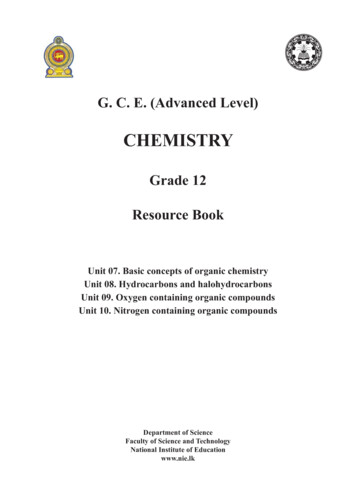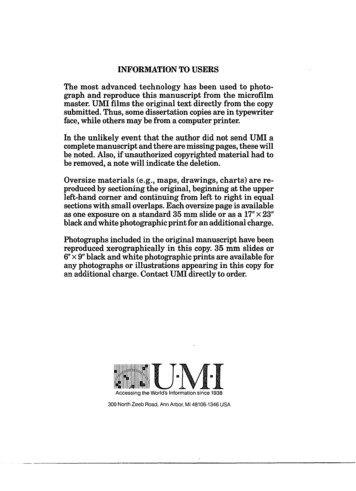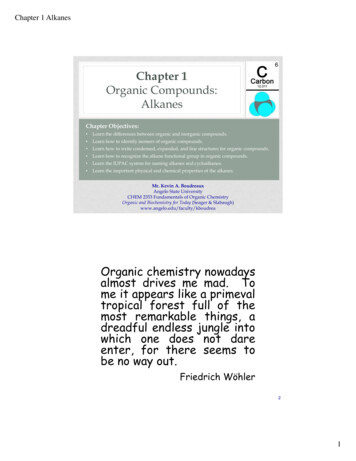
Transcription
Chapter 1 AlkanesChapter 1Organic Compounds:AlkanesChapter Objectives: Learn the differences between organic and inorganic compounds. Learn how to identify isomers of organic compounds. Learn how to write condensed, expanded, and line structures for organic compounds. Learn how to recognize the alkane functional group in organic compounds. Learn the IUPAC system for naming alkanes and cycloalkanes. Learn the important physical and chemical properties of the alkanes.Mr. Kevin A. BoudreauxAngelo State UniversityCHEM 2353 Fundamentals of Organic ChemistryOrganic and Biochemistry for Today (Seager & Slabaugh)www.angelo.edu/faculty/kboudreaOrganic chemistry nowadaysalmost drives me mad. Tome it appears like a primevaltropical forest full of themost remarkable things, adreadful endless jungle intowhich one does not dareenter, for there seems tobe no way out.Friedrich Wöhler21
Chapter 1 Alkanes3What Do We Mean By “Organic”? In everyday usage, the word organic can be found inseveral different contexts:– chemicals extracted from plants and animals wereoriginally called “organic” because they camefrom living organisms.– organic fertilizers are obtained from livingorganisms.– organic foods are foods grown without the use ofpesticides or synthetic fertilizers. In chemistry, the words “organic” and “organicchemistry” are defined a little more precisely:42
Chapter 1 AlkanesWhat is Organic Chemistry? Organic chemistry is concerned with the study ofthe structure and properties of compoundscontaining carbon.– All organic compounds contain carbon atoms.– Inorganic compounds contain no carbons. Mostinorganic compounds are ionic compounds. Some carbon compounds are not considered to beorganic (mostly for historical reasons), such as CO,CO2, diamond, graphite, and salts of carboncontaining polyatomic ions (e.g., CO32-, CN-). Inorganic chemistry is the study of the otherelements and non-carbon containing compounds.5The Periodic Table There are 92 naturally occurring elements, and manyartificial ones, in the (in)famous Periodic Table:IAVIII A1H2Li Be3Na MgII AIII A IV A V A VI A VII AHeB C N O F NeIII B IV B V B VI B VII BIII BIBII BAl Si P S Cl Ar4K Ca Sc Ti V Cr Mn Fe Co Ni Cu Zn Ga Ge As Se Br Kr5Rb Sr Y Zr Nb Mo Tc Ru Rh Pd Ag Cd In Sn Sb Te I Xe6Cs Ba La Hf Ta W Re Os Ir Pt Au Hg Tl Pb Bi Po At Rn7Fr Ra Ac Rf Db Sg Bh Hs Mt Ds Rg CnFlLvLanthanidesCe Pr Nd Pm Sm Eu Gd Tb Dy Ho Er Tm Yb LuActinidesTh Pa U Np Pu AmCm Bk Cf Es Fm Md No Lr63
Chapter 1 AlkanesThe Periodic Table of Organic Chemistry Organic chemists look at the Periodic Table a littledifferently:HBAlMgCr Mn Fe Co Ni CuPdCN O FP S ClBrIPt7Origins of Organic Chemistry Organic literally means “derived from livingorganisms” — organic chemistry was originally thestudy of compounds extracted from living organismsand their natural products. It was believed that only living organisms possessedthe “vital force” necessary to create organiccompounds (“vitalism”). This concept started to change in 1828 afterFriedrich Wöhler showed that it was possible tomake urea, a known “organic compound” from amineral source:ONH4 -OCNAmmoniumCyanateHeatCHNHNHHUrea84
Chapter 1 AlkanesOrigins of Organic Chemistry What this and later experiments showed was that“organic” molecules — even those made by livingorganisms — can be handled and synthesized justlike minerals and metals What was special about these molecules was thatthey contained the element carbon.9What’s So Great About Carbon? Carbons atoms can be linked by strong, stablecovalent bonds.Cneutral carbon, CHCCcarbon cation, C4 carbide anion, C4-HCHHHHCHH105
Chapter 1 AlkanesWhat’s So Great About Carbon? Carbon atoms can form stable bonds to many otherelements (H, F, Cl, Br, I, O, N, S, P, etc.). Mostorganic compounds contain a few hydrogens, andsometimes oxygen, nitrogen, sulfur, phosphorus, etc. Carbon atoms can form complex structures, such aslong chains, branched chains, rings, chiralcompounds (having a particular “handedness”),complex 3D shapes, etc. Because of this variety in bonding and complexity,carbon atoms can form a tremendous variety ofcompounds. More than 16,000,000 organiccompounds are known, as opposed to about 600,000inorganic compounds.11What’s So Great About Carbon? Complex organic compounds can perform a numberof useful biological functions (vitamins,carbohydrates, lipids, proteins, enzymes, ATP, DNA,RNA are all organic compounds) which are studiedin biochemistry. Complex organic compounds are present in the foodswe eat (carbohydrates, proteins, fats, etc.) Most medicines, whether they come from a chemicalplant or a green plant, are organic compounds. Most fuels are organic compounds (wood, coal,natural gas, gasoline, kerosene, diesel fuel, oil, andother petroleum-based products). Complex organic compounds are also useful intechnology (paints, plastics, rubber, textiles, etc.).126
Chapter 1 AlkanesOrganic vs. Inorganic Compounds Organic compounds are held together by covalentbonds, while inorganic compounds are held togetherby ionic bonds.HmethaneHHCHHCHsodium chlorideHHHHCHHNa Cl–Na Cl–Cl–Na Cl–Na Na Cl–Na Cl–Cl–Na Cl–Na 13Organic vs. Inorganic CompoundsTable 1.1PropertyBonding withinmoleculesForces betweenmoleculesProperties of typical organicand inorganic compounds.OrganicInorganicCovalentOften ionicGenerally weakQuite strongliquids, or low Usually high meltingNormal physical state Gases,melting-point solids point solidsUsuallyFlammabilityOften flammablenonflammableSolubility in waterOften lowOften highConductivity ofaqueous solutionsNonconductorConductor147
Chapter 1 Alkanes15Atomic Orbitals on Carbon A carbon atom does not form ions easily, since it hasfour valence electrons (1s22s22p2). It satisfies theoctet rule in compounds by sharing electrons.2p2ss orbitalp orbital1sEnergy These are the orbitals that exist on atomic carbon(not connected to anything).168
Chapter 1 AlkanesHybrid Orbitals When carbon atoms form bonds with each other, wedescribe the resulting bonds using hybrid orbitals,which are formed by mixing (hybridizing) thecarbon’s atomic orbitals. (Linus Pauling, 1950s) When carbon atoms bond to 4 other atoms, the 2sorbital and all three 2p orbitals in the valence shellcombine to produce four sp3 hybrid orbitals: 2s2psp31 atomicorbital3 atomicorbitals4 hybridorbitals 17Hybrid Orbitals2psp32shybridization1s1sEnergy All four sp3 orbitals are at the same energy level,with one electron in each hybrid orbital.189
Chapter 1 AlkanesThe Shape of an sp3 Carbon In order to get as far away from each other aspossible (thus minimizing electron-electronrepulsions), the sp3 orbitals are arranged in the shapeof a tetrahedron around the central carbon atom,with bond angles of 109.5º.sp3109.5 C3Cspsp3sp319The Shape of an sp3 Carbon2010
Chapter 1 AlkanesBonding in Ethane Bonds arise from the overlap of orbitals on adjacentatoms.– End-on-end overlap of sp3 orbitals produces a bond (sigma bond).– All single bonds are -bonds.– Free rotation is possible around -bonds. Each carbon in the ethane molecule, CH3CH3, is sp3hybridized and tetrahedral in shape. Free rotation ispossible around the C—C bond. (See next slide)21Bonding in Ethane (CH3CH3)HHHCCHHHHHHCCHHH2211
Chapter 1 AlkanesCarbon Chains Each carbon atom can form four bonds, either toother carbon atoms, or to different atoms (such as H,O, N, S, P, etc.)Three more sitesto make bondsCC C CCCCCCCCCCCCCCCCCetc.C23Multiple Bonds Carbon atoms form four bonds to other things, butsometimes those bonds are multiple bonds (doubleor triple bonds):CCCCCsingle bondresults from the sharingof two electronsCCCCCdouble bondresults from the sharingof four electronsCCtriple bondresults from the sharingof six electrons2412
Chapter 1 AlkanesIsomers Isomers — compounds having identical molecularformulas, but different arrangements of atoms. Structural Isomers — the atoms in each moleculeare connected in a different order.HHHCCHHC2H6OOHHHHCOHEthyl AlcoholCHHDimethyl EtherColorless liquidColorless gasmp -117 Cmp -139 Cbp 78.5 Cbp -25 Cdensity 0.789 g/mL (20 C)density 0.00195 g/mL (20 C)IntoxicantRefrigerant25Examples: Isomers Draw all possible structures having the formulasC4H10, C5H12, and C6H14.C7H16C8H18C9H20C10H22C20H42C30H62C40H829 isomers13 isomers35 isomers75 isomers366,319 isomers4,111,846,763 isomers!62,481,801,147,341 isomers!2613
Chapter 1 AlkanesExamples: Isomers Which of the followingmolecules is a structuralisomer of OHH3CCH2CH27Functional Groups Organic molecules are often organized by structurescalled functional groups, which are characteristicarrangement of atoms which define many of thephysical and chemical properties of a class oforganic compounds.– The simplest of the functional groups are thehydrocarbons, which include the alkanes,alkenes, alkynes, and aromatic hydrocarbons.– Many functional groups contain oxygen atoms,such as alcohols, ethers, aldehydes, ketones,carboxylic acids, and esters.– Some other functional groups contain nitrogenatoms, such as the amines and amides. Molecules with the same functional group tend toshare similar chemical and physical properties.2814
Chapter 1 AlkanesTable 1.2 Classes and functional groups of organic compoundsClassFunctional GroupAlkaneExample of expandedstructural COHCHCCH2ethene (ethylene)HCCHethyne (acetylene)HCCHHCHbenzeneHHOHCH3CH2OHHCH3OCH3ethyl UPAC / Common nameHHAlkyneExample of condensedstructural formulaOCmethoxymethane(dimethyl ether)HH29Table 1.2 Classes and functional groups of organic compoundsClassFunctional GroupExample of expandedstructural formulaOAldehydeCHHHOCCExample of condensedstructural formulaIUPAC / Common nameOCH3CHHethanal (acetaldehyde)HOKetoneCCCHHOHCCCHOCarboxylic acidCHOHOHCH3CCH3HCH3COH2-propanone (acetone)HHOCCOOethanoic acid (acetic acid)HOEsterHCOCHOCCOHHNHCNHCHCH3COCH3methyl ethanoate(methyl HONHHCH3CNH2ethanamide (acetamide)3015
Chapter 1 Alkanes31A Moderately Complex Organic MoleculeHHHCHHHHHHHHHCCCH H C HHCCCCCCCCCCHOHHCHCCHHCCHCCHHHHHCHHHCHHHCHHHHH CHHHHCHHH3216
Chapter 1 AlkanesExpanded Structural Formulas In expanded structural formulas (Lewis formulas,Lewis structures), all atoms and bonds are ed Structural Formulas In condensed structural formulas, only specificbonds are shown; this is useful in reducing thenumber of C—H bonds that must be OHCH3CH2CH3CH3CH2OCH2CH33417
Chapter 1 AlkanesLine Drawings In line drawings (line-angle formulas, skeletalstructures, stick figures), bonds are represented bylines; everywhere two lines meet or a line begins orends is a C atom. H’s on C’s are not shown (exceptfor emphasis); H’s on other atoms must be shown.OHO35Drawing Organic MoleculesExpanded structural formula(Lewis structure)HHHHHCCCCHHHHCondensed structural formulasCH3 CH2 CH2 CH3HCH3CH2CH2CH3CH3(CH2)2CH3 CH3Line drawing CH C CH23618
Chapter 1 AlkanesDrawing Organic MoleculesHCholesterolHHCHHHHHHHHHCCCH H C HHCCCCCCCCCCHOCCHHCCHCCHHHHHCHHHCHHHCHHHHHHHHCCHHH CHHHHExpanded Structural Formula37Drawing Organic CHHOCH3 CHCH2CH2CH2CH(CH3)2CHCondensed Structure3819
Chapter 1 AlkanesDrawing Organic MoleculesHOLine Drawing39Examples: Drawing Organic Molecules Draw acceptable condensed structures and linedrawings associated with the following expandedstructural HHHCHHHHH4020
Chapter 1 AlkanesExamples: Drawing Organic Molecules Draw an acceptable expanded structure and linedrawing for the molecule CH3CH2CH2OH. Draw an acceptable expanded structure and linedrawing for the molecule (CH3)3CCH2CH(CH3)CH3.41Examples: Drawing Organic Molecules Draw acceptable expanded structures, condensedstructures, and line drawings for the followingmolecules:– isopropyl alcohol, CH3CH(OH)CH3– acetic acid, CH3COOH– acetaldehyde, CH3CHO– acetone, CH3COCH34221
Chapter 1 Alkanes43Hydrocarbons Hydrocarbons — compounds that contain onlycarbon and hydrogen. Saturated Hydrocarbons — contain only carboncarbon single bonds. H HHCCHHHAlkanes Unsaturated Hydrocarbons — contain carboncarbon double or triple ics22
Chapter 1 AlkanesAlkanes Alkanes are saturated hydrocarbons — each carbonholds the maximum number of hydrogen atoms).– Alkanes contain only carbon-carbon single bonds.– General formula: CnH2n 2 (no rings). Most chemical reactions require a functional group“handle” to proceed. Since alkanes don’t really havefunctional groups, they aren’t very useful in manybiologically important processes.– Since alkanes undergo combustion easily, theyare a good source of energy (e.g., gasoline).– Alkanes also provide the raw materials for theproduction of many other more complexsubstances (plastics, etc.).45Some Common Alkanes Methane, CH4– major component of natural gas ( 85%), which isproduced by bacterial decomposition oforganisms in the absence of oxygen (marsh gas,cow flatulence).– burns cleanly, so is useful for cooking.– odorless — ethanethiol is added to make naturalgas leaks detectable. Ethane, CH3CH3 (C2H6) — a minor component ofnatural gas ( 10%). Propane, CH3CH2CH3 (C3H8) — used as anindustrial fuel, and in home heating and cooking.4623
Chapter 1 AlkanesSome Common Alkanes Butane, CH3CH2CH2CH3 (C4H10)– cigarette lighters– Butane is an unbranched (normal) alkane.There is also a branched alkane with the formulaC4H10, having a three-carbon chain with a onecarbon group connected to the middle.– We must give the other isomer a different name:CH3CH(CH3)CH3 [or CH3CH(CH3)2] is namedisobutane (or 2-methylpropane).– Butane and isobutane are structural isomers ofeach ormations of Alkanes Conformation — the different arrangements ofatoms in space achieved by rotation about singlebonds. Structures which are related to each other by rotationaround a single bond are the same molecule.CH3CH2CH2CH3CH3CH3HH H34824
Chapter 1 AlkanesExamples: Conformations and Isomers Which of the following groups represent structuralisomers, and which are simply the same 3CH3CH2CH2CH2CH249Examples: Conformations and Isomers Which of the following groups represent structuralisomers, and which are simply the same 3CH3CHCHCH3CH2CH2 CH3CH3CH2 CHCH2CH35025
Chapter 1 AlkanesAlkane Nomenclature Straight-chain alkanes are named by combining aprefix which indicates the number of carbon atomsin the chain, and a suffix indicating the functionalgroup of the molecule.No. of -ene-yne51Alkane Nomenclature When alkanes are branched, things get morecomplex. Remember there are two isomers of C4H10:CH3CH3CH2CH2CH3CH3CHCH3ButaneIsobutane There are three isomers of neCH3CH3CCH3CH3Neopentane There are 75 isomers of C10H22! We need a way to name molecules that doesn’trequire memorizing a huge number of prefixes.5226
Chapter 1 AlkanesIUPAC System of Chemical Nomenclature The system of nomenclature used to name organiccompounds was developed by the InternationalUnion of Pure and Applied Chemistry (IUPAC).– A root identifies the longest continuous chain ofcarbon atoms.– A suffix identifies the main functional group inthe molecule.– A set of prefixes identifies the numbers andpositions of the substituents (groups which areattached to the longest chain). (Alkyl groups aresubstituents which contain a carbon chain.)PrefixRootEndingnumber andidentity ofattached groupslongest carbonchainfunctionalclass53IUPAC Nomenclature of Alkanes Step 1. Identify and name the longest continuouschain of C atoms (#C -ane for alkanes). If there ismore than one way to get the same # of C’s in thelongest chain, use the one that gives more substituents.CH3CH3CH3 CH CH2 CH2CH3CH3 CHCH3CH2CCH3CH3CH3CH2CH3 CH CH2 CHCH3CH3CH3CH3 CHCH3CH3 CH2 CH CH2 CH3CH2 CH3CH3 CH2 CH CH2 CH CH2 CH35427
Chapter 1 AlkanesIUPAC Nomenclature of Alkanes Step 2. Number the atoms in the longest chain.– Number consecutively from the end that will givethe lower number to any C to which a group isattached.– If two or more alkyl groups are attached to thelongest chain, use the numbering path that givesthe lowest number for the first point of difference.– If two different alkyl groups are attached at thesame distance from either end of the chain, theone that comes first in alphabetical order has thehighest priority.55IUPAC Nomenclature of Alkanes Step 3. Name the alkyl groups (#C -yl) andother substituents connected to the longest chain.In front of each alkyl group name, put the number ofthe carbon the group is attached to, separated fromthe name by a dash (e.g., 2-methyl). Step 4. If there is more than one of a particularsubstituent, combine them into a single word usingthe appropriate counting prefix (di-, tri-, tetra-,etc.). Include all of the carbon numbers which thegroups are attached to, separated by commas (e.g.,2,2,3-trimethyl).No. of Groups12345Prefix—ditritetrapenta-No. of Groups678910Prefixhexaheptaoctanonadeca-5628
Chapter 1 AlkanesIUPAC Nomenclature of Alkanes Step 5. Arrange the alkyl groups in front of theparent name in alphabetical order (ignoringcounting prefixes, sec- and tert-; iso- is used inalphabetizing). Separate numbers from each otherby commas, and numbers from words by dashes.CH3CH3CH3 CH CH2 CH2CH3CH3 CHCH3CH2CCH3CH3CH3CH2CH3 CH CH2 CHCH3CH3CH3CH3 CHCH3CH3 CH2 CH CH2 CH3CH2 CH3CH3 CH2 CH CH2 CH CH2 CH357Examples: Alkane Nomenclature Draw structural formulas and give the correct namesfor all of the possible structural isomers of butane(C4H10).5829
Chapter 1 AlkanesExamples: Alkane Nomenclature Draw structural formulas and give the correct namesfor all of the possible structural isomers of pentane(C5H12).59Examples: Alkane Nomenclature Draw structural formulas and give the correct namesfor all of the possible structural isomers of hexane(C6H14).6030
Chapter 1 AlkanesExamples: Alkane Nomenclature Provide acceptable IUPAC names for the H2CH3CH3CH3CHCH3CH2CHCH3 CH3CH3CH3CH2CHCHCH361Examples: Alkane Nomenclature Provide acceptable IUPAC names for the followingmolecules:CH2CH2 CH3CH3CH2CHCH2 CH3CH3 CH2CH3C CH3CH2 CH2CH3CH2 CH2CH2CHCH2CH2CH2CH3CH3CH2 CH2 CH3CH2 CH3CH3CH2CH2CH2CHCH2CH3 CH CH3CH26231
Chapter 1 AlkanesCommon SubstituentsCommon Alkyl H3sec-butylCH2CH2CH3CH CH2 CH3CH3CH3isopropylCH2 CH CH3isobutylCH CH3CH3tert-butylCommon Nonalkyl inoNH263Examples: Alkane Nomenclature Provide acceptable IUPAC names for the followingmolecules:CH3 CH2CH3BrC CH2CHClCH3CH3CH3 CH CH3CH3 CH CH2 CH CH2 CH2 CH3FCH3CHCH CH3CH2CH3CH3CH3CCH3CH3CH2CH2CHCHCH2CH2CH3NO26432
Chapter 1 AlkanesExamples: Alkane Nomenclature Provide acceptable IUPAC names for the followingmolecules:65Examples: Alkane Nomenclature Draw condensed structural formulas or line drawingsfor each of the following compounds:– hexane– 3-ethylpentane– 2,2-dimethylbutane6633
Chapter 1 AlkanesExamples: Alkane Nomenclature Draw condensed structural formulas or line drawingsfor each of the following compounds:– 3-ethyl-2-methylhexane– 4-isopropyloctane– mples: Alkane Nomenclature The following names have been assigned incorrectly.Draw the structure corresponding to the name, andassign the correct IUPAC name.– 3-sec-butylpentane– 2-ethyl-2,6-dimethylhexane6834
Chapter 1 Alkanes69Cycloalkanes Alkanes may also possess cyclic structures inaddition to the straight- and branched-chain acyclicmolecules we have already seen. General formula: CnH2n (for one ring)HH 60 CHNote that thesemolecules arenot structuralisomers ofeach 5
Chapter 1 AlkanesCycloalkane Nomenclature When naming cycloalkanes, the ring is taken to bethe longest chain; the prefix cyclo- is added to thenormal root -suffix. When mono-substituted cycloalkanes are named, itis not necessary to specify the position number,since all positions in the ring are equivalent. When more than one substituent is located on a ring,the numbering begins at the carbon to which thegroup is attached which comes first in alphabeticalorder, and then proceeds in a direction which givesthe lowest possible number to the next attachedgroup.71Examples: Cycloalkane Nomenclature Provide acceptable IUPAC names for the followingmolecules:CH3CH3CH3ClCH3CH37236
Chapter 1 AlkanesExamples: Cycloalkane Nomenclature Provide acceptable IUPAC names for the followingmolecules:CH3CH3CH3CH3CH2CH3CH3ClCH CH3ClCH3ClCH2 CH CH373The Shape of Cycloalkanes Cyclopropane has bond angles of 60 , which is bentfar away from the “normal” 109.5 bond angles ofstraight-chain alkanes. It is a flat molecule.HH 60 HHHH Cyclobutane has bond angles of about 90 ; it is alsoless stable than a “normal” alkane. It is mostly flat,but there is some slight puckering of the ring.HHHH 90 HHHH7437
Chapter 1 AlkanesThe Shape of Cycloalkanes Cyclopentane has bond angles of about 108 ; itforms a mostly flat but slightly puckered ring.Cyclopentane rings are very common in nature.HHHHHH 108 HHH H If cyclohexane were flat, the bond angles would beabout 120 ; but this molecule can adopt a “chair” or“boat” conformation in which the bond angles are109.5 . Cyclohexane rings are extremely eoisomers of Cycloalkanes The molecules below are different moleculesbecause there is no free rotation around carboncarbon bonds in CH3trans-1,2-dimethylcyclopentane These molecules are stereoisomers — compoundswith the same molecular and structural formula butdifferent spatial arrangements of atoms. Stereoisomers in which the spatial arrangement ismaintain by rings (or double bonds) are calledgeometric isomers or cis-trans isomers.7638
Chapter 1 AlkanesExamples: Stereoisomers State whether each possible pairing of the moleculesbelow are structural isomers, geometric isomers, orthe same 3CH3CH377Examples: Stereoisomers Provide acceptable IUPAC names for the followingmolecules:BrBrBrBr7839
Chapter 1 Alkanes79Physical Properties of Alkanes Since alkanes are composed of relatively nonpolarC—C bonds and C—H bonds, alkanes arenonpolar molecules. Because they have only weak attractions for eachother, they tend to have lower melting points andboiling points than other organic compounds ofcomparable molecular weights. The straight chain alkanes make up a homologousseries in which each members differs from aprevious member by having one additional CH2group. In a homologous series, the physicalproperties are closely related and vary in asystematic way.8040
Chapter 1 Alkanes81Physical Properties of Alkanes The general rule when judging solubility is “likedissolves like” — polar substances mixes with polarsubstances, nonpolar with nonpolar, but not polarwith nonpolar. Alkanes (nonpolar) are insoluble in water (polar),and since they are less dense than water, they float(e.g., oil slicks). Alkanes and other substances that do not dissolve inwater are often referred to as being hydrophobic(“water fearing”). Liquid alkanes of high molecular weight serve asemollients (skin softeners) to replace oils washedaway by bathing or swimming.– Vaseline is a semisolid mixture of alkanes.8241
Chapter 1 AlkanesAlkane Reactions Alkanes are the least reactive of all organiccompounds. They do not usually react with strongacids or bases, or with most oxidizing or reducingagents. They do, however, burn very easily in combustionreactions, releasing a great deal of energy:CH4(g) 2O2(g) CO2(g) 2H2O(g) 212.9 kcalC3H8(g) 5O2(g) 3CO2(g) 4H2O(g) 488.8 kcal2C8H18(g) 25O2(g) 16CO2(g) 18H2O(g) 2448 kcal83Alkane Reactions In the absence of enough oxygen for completeconversion to carbon dioxide, some common wasteproducts are generated in the incomplete burning ofalkanes:CH4(g) 2O2(g) CO2(g) 2H2O(g)CH4(g) 3/2 O2(g) CO(g) 2H2O(g)CH4(g) O2(g) C(s) 2H2O(g)– CO, carbon monoxide, is poisonous, colorless,and odorless. In the exhaust train of most cars, acatalytic converter converts CO to CO2.– Solid elemental carbon produces engine deposits;but this reaction is done to produce lampblack,which is used in some ink pigments.8442
Chapter 1 AlkanesAlkyl Halides Alkyl halides, or haloalkanes, are alkanes in whichone or more hydrogen atoms are replaced byhalogen atoms (F, Cl, Br, or I). Most alkyl halides are not very water-soluble. Alkylfluorides and chlorides have densities that are higherthan those of alkanes, but still less than that of water.Alkyl bromides and iodides are generally moredense than water. Compounds containing more thanone halogen are often more dense than water. Alkyl halides are named as alkanes with halosubstituents (fluoro-, bromo-, chloro-, and iodo-). A number of simple alkyl halides are better knownby their common names; for instance, CHCl3,trichloromethane, is almost always referred to as“chloroform.”85Examples: Nomenclature of Alkyl Halides Provide acceptable IUPAC names for the H3FHCCFHCHCH2CH2CH2CHBrCH3ClFClCl8643
Chapter 1 AlkanesSome Common Alkyl hylene chloride)A colorless , mildly toxicliquid (bp 41 C) more densethan water. It is used as apaint remover and degreaser.It is also used to decaffeinatecoffee beans; since it hassuch a low boiling point, theresidual solvent can beremoved from the beans atfairly low temperatures.Trichloromethane (chloroform)A colorless liquid (bp 60 C); avery commonly used organicsolvent. Chloroform vapor is aanesthetic: James YoungSimpson was the first to usechloroform as an anestheticduring childbirth in 1846(presumably, not on himself!),and it was widely used in surgeryin the 19th and early 20thcenturies. However, sincechloroform is carcinogenic, andtoxic to the liver, it is not widelyused for this purpose anymore.Tetrachloromethane(carbon tetrachloride)Formerly a common organicsolvent, and was widely usedfor dry cleaning and spotremoval; it has been shown tobe toxic and carcinogenic,and contributes to ozonedepletion, so it has beenreplaced by other solvents.87Some Common Alkyl HalidesClClHCCClHFH1,1,1-TrichloroethaneFormerly a very commonly usedorganic solvent; heavily used indry cleaning, but it has beenreplaced by other solvents (suchas ane (Halon 1211)An example of a halon, a haloalkane that hasbromine atoms in addition to chlorine and fluorineatoms. Halons are very stable, and are useful infire extinguishers, since they do not damageelectronic equipment. Their use has largely beenphased out under the Montreal Protocols, but theyare still used in fire suppression systems aboardsome aircraft, since no completely satisfactory andsafe alternatives have been discovered.8844
Chapter 1 AlkanesChlorofluorocarbons (CFCs)ClFCClFFClCFHDichlorodifluoromethane (Freon-12)Chlorodifluoromethane (Freon-22)An example of the chlorofluorocarbons (CFCs, orAn example of a hydrochlorofluorocarbonfreons), developed in the 1920s; they are relatively(HCFC), developed as alternatives to thenontoxic, very unreactive, and boil at low temperatures, and CFCs. The HCFCs are not fully halogenated,were thus ideal for use as refrigerants; they were alsoand are less stable than the CFCs, and degradewidely used as aerosol propellants and as foaming agents.before they reach the upper atmosphere.Unfortunately, they persist in the environment for a longFHtime (up to a century), and make their way into the upperatmosphere, where they are split by high energy light fromFCCFthe Sun, releasing chlorine atoms. These Cl atoms destroyozone in the stratospheric ozone layer that shields us frommuch of the Sun's UV radiation. (F. Sherwood Rowland,FHMario J. Molina, Paul Crutzen, Nobel Prize in 5) In 1987, a treaty called the Montreal Protocol onA hydrofluorocarbon (HFC), anotherSubstances that Deplete the Ozone Layer was signed, whichgroup of CFC-alternatives that are notcut back on the production and use of CFCs; in 1990, indamaging to the ozone layer. Freon-134aresponse to the alarming increase in the size of the "ozoneis now widely used in the air conditioninghole" over the South Pole, the agreement was extended tosystems of automobiles in place ofbecome a ban on the use of CFCs starting in 2000.89Freon-12.Petroleum Petroleum is a mixture of hydrocarbons formedover millions of years, primarily from the decay ofmicroscopic ocean-dwelling plants and animals.The resulting crude oil collects in undergroundpockets in sedimentary rock. Petroleum is separated into different fractions byfractional distillation. Most petroleum products are burned as fuel, butabout 2% is used to synthesize other organiccompounds. (That’s still a lot!) Over half of all synthetic industrial organics,including dyes, drugs, plastics, fibers, detergents,insecticides, etc., are made from petroleum sources
Normal physical state Gases, liquids, or low melting-point solids Usually high melting-point solids Flammability Often flammable Usually nonflammable Solubility in water Often low Often high Conductivity of aqueous solutions Nonconductor Conductor Table 1
